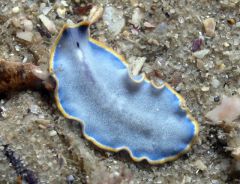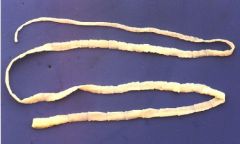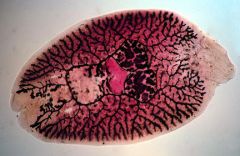![]()
![]()
![]()
Use LEFT and RIGHT arrow keys to navigate between flashcards;
Use UP and DOWN arrow keys to flip the card;
H to show hint;
A reads text to speech;
24 Cards in this Set
- Front
- Back
|
Platyhelminthes are also known as... |
Flatworms |
|
|
How do they reproduces? |
Sexual: Penis fencing Asexual: Regeneration, Budding |
|
|
Platyhelminthes Nervous System |
Nerve Cord - Transverse - Neural Ganglia |
|
|
Besides ocelli and statocysts, name another sensory organ for platyhelminthes |
Chemoreceptors: taste |
|
|
Platyhelminthes Digestive System |
Cavity Incomplete gut: one hole Hooks and suckers |
|
|
Platyhelminthes Reproduction |
Genital pore |
|
|
Platyhelminthes Excretory System |
Flame Cell: kidney Tube Cell: fluid Excretory Pore: excretion |
|
|
How do the platyhelminthes move? |
Cilia and muscle cells |
|
|
Class: Free-living worms marine, cilia and muscular pharynx Grouped by digestive cavities |
Class Tubellaria |
|
|
Class: Endoparasitic 2 or more hosts Known as flukes |
Class Trematoda |
|
|
Class: Endoparasitic 2 or more hosts Known as tapeworms |
Class Cestoda |
|
|
Class: Ectoparasitic worm Also known as flukes |
Class Monogenea |
|
|
Pork Tapeworm |
Taenia solium (Cestoda) |
|
|
Beef Tapeworm |
Taenia saginatta (Cestoda) |
|
|
Lung Fluke |
Paragonimus wetermani |
|
|
Liver Fluke |
Chlonorchis sinesis |
|
|
Blood Fluke |
Schistosoma japonicum (Trematoda) - most infectious |
|
|
Concentration of sense organs, nervous control, etc., at the anterior end of the body |
Cephalization |
|
|
Platyhelminthes develop this tissue |
Parenchyma |
|

|
Tubellaria |
|

|
Fluke Trematoda |
|

|
Tapeworm Cestoda |
|

|
Monogenea |
|
|
Sickness by parasitic worms |
Schistosomiasis |

